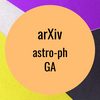383 episódios

Shattering and growth of cold clouds in galaxy clusters: the role of radiative cooling, magnetic fields and thermal conduction
30/11/2022 | 1min
Shattering and growth of cold clouds in galaxy clusters: the role of radiative cooling, magnetic fields and thermal conduction by Fred Jennings et al. on Wednesday 30 November In galaxy clusters, the hot intracluster medium (ICM) can develop a striking multi-phase structure around the brightest cluster galaxy. Much work has been done on understanding the origin of this central nebula, but less work has studied its eventual fate after the originally filamentary structure is broken into individual cold clumps. In this paper we perform a suite of 30 (magneto-)hydrodynamical simulations of kpc-scale cold clouds with typical parameters as found by galaxy cluster simulations, to understand whether clouds are mixed back into the hot ICM or can persist. We investigate the effects of radiative cooling, small-scale heating, magnetic fields, and (anisotropic) thermal conduction on the long-term evolution of clouds. We find that filament fragments cool on timescales shorter than the crushing timescale, fall out of pressure equilibrium with the hot medium, and shatter, forming smaller clumplets. These act as nucleation sites for further condensation, and mixing via Kelvin-Helmholtz instability, causing cold gas mass to double within 75 Myr. Cloud growth depends on density, as well as on local heating processes, which determine whether clouds undergo ablation- or shattering-driven evolution. Magnetic fields slow down but don't prevent cloud growth, with the evolution of both cold and warm phase sensitive to the field topology. Counter-intuitively, anisotropic thermal conduction increases the cold gas growth rate compared to non-conductive clouds, leading to larger amounts of warm phase as well. We conclude that dense clumps on scales of $500$ pc or more cannot be ignored when studying the long-term cooling flow evolution of galaxy clusters. arXiv: http://arxiv.org/abs/http://arxiv.org/abs/2211.09183v2

A Ghost in Boötes: The Least Luminous Disrupted Dwarf Galaxy
30/11/2022 | 0min
A Ghost in Boötes: The Least Luminous Disrupted Dwarf Galaxy by Vedant Chandra et al. on Wednesday 30 November We report the discovery of Specter, a disrupted ultrafaint dwarf galaxy revealed by the H3 Spectroscopic Survey. We detected this structure via a pair of comoving metal-poor stars at a distance of 12.5 kpc, and further characterized it with Gaia astrometry and follow-up spectroscopy. Specter is a $25^\circ \times 1^\circ$ stream of stars that is entirely invisible until strict kinematic cuts are applied to remove the Galactic foreground. The spectroscopic members suggest a stellar age $\tau \gtrsim 12$ Gyr and a mean metallicity $\langle\text{[Fe/H]}\rangle = -1.84_{-0.18}^{+0.16}$, with a significant intrinsic metallicity dispersion $\sigma_{ \text{[Fe/H]}} = 0.37_{-0.13}^{+0.21}$. We therefore argue that Specter is the disrupted remnant of an ancient dwarf galaxy. With an integrated luminosity $M_{\text{V}} \approx -2.6$, Specter is by far the least-luminous dwarf galaxy stream known. We estimate that dozens of similar streams are lurking below the detection threshold of current search techniques, and conclude that spectroscopic surveys offer a novel means to identify extremely low surface brightness structures. arXiv: http://arxiv.org/abs/http://arxiv.org/abs/2207.13717v2

High- z Quasar Candidate Archive: A Spectroscopic Catalog of Quasars and Contaminants in Various Quasar Searches
30/11/2022 | 1min
High- z Quasar Candidate Archive: A Spectroscopic Catalog of Quasars and Contaminants in Various Quasar Searches by Da-Ming Yang et al. on Wednesday 30 November We present the high-$z$ quasar candidate archive (HzQCA), summarizing the spectroscopic observations of 174 $z\gtrsim5$ quasar candidates using Keck/LRIS, Keck/MOSFIRE, and Keck/NIRES. We identify 7 candidates as $z\sim 6$ quasars 3 of them newly reported here, and 51 candidates as brown dwarfs. In the remaining sources, 74 candidates are unlikely to be quasars; 2 sources are inconclusive; the others could not be fully reduced or extracted. Based on the classifications we investigate the distributions of quasars and contaminants in color space with photometry measurements from DELS ($z$), VIKING/UKIDSS ($YJHK_s$/$YJHK$), and un\textit{WISE} ($W1W2$). We find that the identified brown dwarfs are not fully consistent with the empirical brown dwarf model that is commonly used in quasar candidate selection methods. To refine spectroscopic confirmation strategies, we simulate synthetic spectroscopy of high-$z$ quasars and contaminants for all three instruments. The simulations utilize the spectroscopic data in HzQCA. We predict the required exposure times for quasar confirmation and propose and optimal strategy for spectroscopic follow-up observations. For example, we demonstrate that we can identify a $m_J=21.5$ at $z=7.6$ or a $m_J=23.0$ at $z=7.0$ within 15\,min of exposure time with LRIS. With the publication of the HzQCA we aim to provide guidance for future quasar surveys and candidate classification. arXiv: http://arxiv.org/abs/http://arxiv.org/abs/2211.16996v1

Extreme nature of four blue-excess dust-obscured galaxies revealed by optical spectroscopy
30/11/2022 | 0min
Extreme nature of four blue-excess dust-obscured galaxies revealed by optical spectroscopy by Akatoki Noboriguchi et al. on Wednesday 30 November We report optical spectroscopic observations of four blue-excess dust-obscured galaxies (BluDOGs) identified by Subaru Hyper Suprime-Cam. BluDOGs are a sub-class of dust-obscured galaxies (DOGs, defined with the extremely red color $(i-[22])_{\rm AB} \geq 7.0$; Toba et al. 2015), showing a significant flux excess in the optical $g$- and $r$-bands over the power-law fits to the fluxes at the longer wavelengths. Noboriguchi et al. (2019) has suggested that BluDOGs may correspond to the blowing-out phase involved in a gas-rich major merger scenario. However the detailed properties of BluDOGs are not understood because of the lack of spectroscopic information. In this work, we carry out deep optical spectroscopic observations of four BluDOGs using Subaru/FOCAS and VLT/FORS2. The obtained spectra show broad emission lines with extremely large equivalent widths, and a blue wing in the CIV line profile. The redshifts are between 2.2 and 3.3. The averaged rest-frame equivalent widths of the CIV lines are $160\pm33$ $\mathrm{\mathring{A}}$, $\sim$7 times higher than the average of a typical type-1 quasar. The FWHMs of their velocity profiles are between 1990 and 4470 ${\rm km\ s^{-1}}$, and their asymmetric parameters are 0.05 and 0.25. Such strong CIV lines significantly affect the broad-band magnitudes, which is partly the origin of the blue excess seen in the spectral energy distribution of BluDOGs. Their estimated supermassive black hole masses are $1.1\times10^8 < M_{\rm BH}/M_\odot < 5.5 \times 10^8$. The inferred Eddington ratios of the BluDOGs are higher than 1 ($1.1< \lambda_{\rm Edd} < 3.8$), suggesting that the BluDOGs are in a rapidly evolving phase of supermassive black holes. arXiv: http://arxiv.org/abs/http://arxiv.org/abs/2211.16748v1

Insights on the origin of ORCs from cosmological simulations
30/11/2022 | 0min
Insights on the origin of ORCs from cosmological simulations by Klaus Dolag et al. on Wednesday 30 November We investigate shock structures driven by merger events in high-resolution simulations that result in a galaxy with a virial mass M ~ 1e12 Msol. We find that the sizes and morphologies of the internal shocks resemble remarkably well those of the newly-detected class of odd radio circles (ORCs). This would highlight a so-far overlooked mechanism to form radio rings, shells and even more complex structures around elliptical galaxies. Mach numbers of M = 2-3 for such internal shocks are in agreement with the spectral indices of the observed ORCs. We estimate that ~5 percent of galaxies could undergo merger events which occasionally lead to such prominent structures within the galactic halo during their lifetime, explaining the low number of observed ORCs. At the time when the shock structures are matching the physical sizes of the observed ORCs, the central galaxies are typically classified as early-type galaxies, with no ongoing star formation, in agreement with observational findings. Although the energy released by such mergers could potentially power the observed radio luminosity already in Milky-Way-like halos, our predicted luminosity from a simple, direct shock acceleration model is much smaller than the observed one. Considering the estimated number of candidates from our cosmological simulations and the higher observed energies, we suggest that the proposed scenario is more likely for halo masses around 1e13 Msol in agreement with the observed stellar masses of the galaxies at the center of ORCs. Such shocks might be detectable with next generation X-ray instruments like the Line Emission Mapper (LEM). arXiv: http://arxiv.org/abs/http://arxiv.org/abs/2208.15003v2
Mais podcasts de Ciência
Podcasts em tendência em Ciência
Sobre Astro arXiv | astro-ph.GA
Ouça Astro arXiv | astro-ph.GA, Hidden Brain e muitos outros podcasts de todo o mundo com o aplicativo o radio.net

Obtenha o aplicativo gratuito radio.net
- Guardar rádios e podcasts favoritos
- Transmissão via Wi-Fi ou Bluetooth
- Carplay & Android Audo compatìvel
- E ainda mais funções
Obtenha o aplicativo gratuito radio.net
- Guardar rádios e podcasts favoritos
- Transmissão via Wi-Fi ou Bluetooth
- Carplay & Android Audo compatìvel
- E ainda mais funções


Astro arXiv | astro-ph.GA
baixe o aplicativo,
ouça.

































